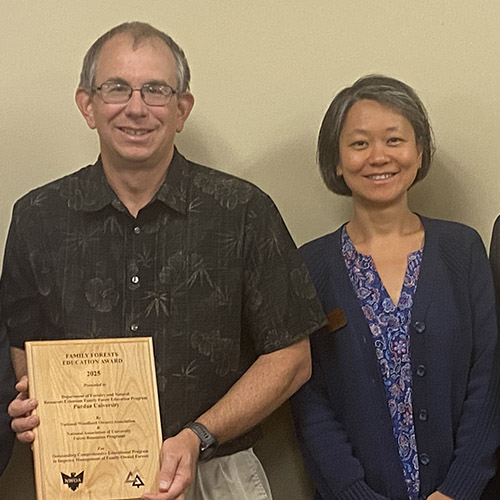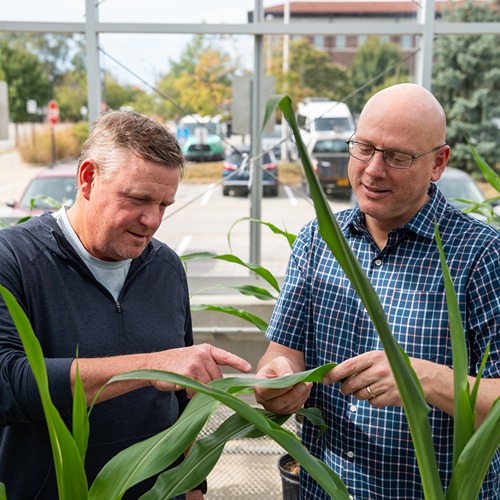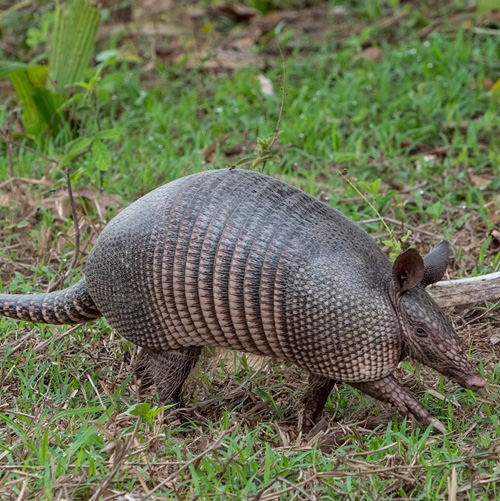FNR Field Report: Sam Lima
Students from Purdue Forestry and Natural Resources took their classroom knowledge to the field for summer internships and paid positions as well as research opportunities across the world, gaining valuable experience, hands-on training and career guidance. The FNR Field Reports series will offer updates from those individuals as summer positions and experiences draw to a close.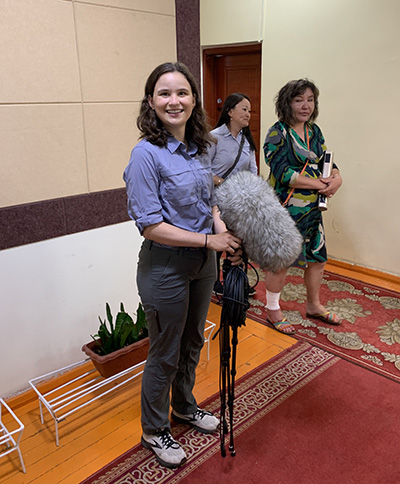
PhD student Sam Lima spent the summer in Mongolia conducting research on soundscapes and the sonic practices of traditional herders in remote rural locations of the Arkhangai Province, alongside fellow PhD student Francisco Rivas Fuenzalida and Dr. Bryan Pijanowski.
Lima, who grew up in Scottsdale, Arizona and received her bachelor’s degree in ecology and evolutionary biology from the University of Michigan, joined the Pijanowski lab in 2021. Prior to coming to Purdue, Lima worked under Dr. Nyeema Harris at Michigan doing camera trapping and molecular work focused on mammals.
She also gained experience through several summer internships. The summer after her freshman year, she worked as a science educator at the Maryland Science Center in Baltimore. The following year, she was an intern at the National Aquarium in Baltimore, where she worked in bird husbandry at the Australia exhibit. As a junior, she expanded on her interest in birds as an REU intern at the University of Kentucky, where she worked with Dr. David Westneat conducting an experiment with diet in a captive house sparrow population, looking at how levels of corticosteroid, the stress hormone, added to their diet affected their foraging behavior.
“When I was looking for a graduate school, I wanted a program that was more applied, because Michigan’s program is much more focused on theory,” Lima said. “When I found Dr. Pijanowski’s lab and his research with remote sensing and soundscapes, I was pretty excited about it because I had worked with camera traps and I had an interest in remote sensing. When he saw that I had a degree in ecology and anthropology through my double major at Michigan, he mentioned the project in Mongolia and that it had a cultural and ecological aspects to it. It was a lot of really good timing and luck. I feel really lucky to be here at Purdue.”
Although Lima knew she would be part of the Mongolia project, the COVID 19 pandemic had the team’s trip to Mongolia in question.
“It was very much uncertain if we were going to go,” Lima said. “One week, we were all going, the next half of us were going. It went back and forth a lot, so I was just focused on trying to help prepare everything that we needed to bring and making sure people had the things they needed. I helped mail some things to our collaborators and worked to make sure we had the computers that we needed. I also took care of all of the 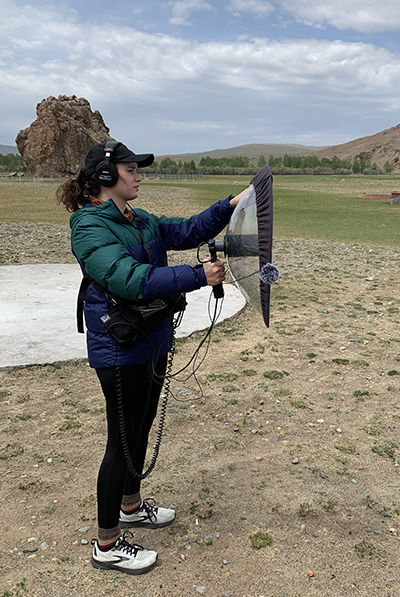 supplies that we ordered and doing inventory. I had everything laid out in our lab, all of the microphones and acoustic equipment, our tents and sleeping bags and the crazy amount of stuff that we brought to Mongolia.”
supplies that we ordered and doing inventory. I had everything laid out in our lab, all of the microphones and acoustic equipment, our tents and sleeping bags and the crazy amount of stuff that we brought to Mongolia.”
In addition to preparing for the group project on soundscapes supported by the National Science Foundation’s CNH2 Program (see news summary at 2:44 mark), Lima also was working with Dr. Laura Zanotti from the Purdue Department of Anthropology to write a proposal for a project looking at the process of co-production and how the creation of the Mongolia project and its framework can be applied to future projects to create highly collaborative projects that are relevant to local people and take their needs into account. While the IRB for that project was not approved in time for this summer’s trip, Lima was able to do a survey in line with the original IRB and has more planned for her next trip to Mongolia in 2023.
Once the large travel party arrived in Mongolia, Lima helped organize a two-day planning workshop between researchers and local community members. Alongside local anthropologists and government officials, researchers presented their ideas to local collaborators, including the Mongolian herders.
“The point of the workshop was to present our project to the local community and also to ask for their help to plan the project and to ask them if they wanted to be involved further,” Lima explained. “We told the local herders about the capabilities that we had and what we wanted to look at and worked with them to see what they thought we should do. We had four locations and six sensors that we wanted to put in each area, one in a riparian zone, one in an upland grassland and one in a forest. We asked the herders what we should do with the other three; where we should put the sensors within the landscape in each of our four locations? 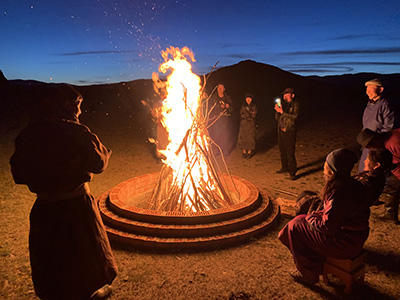 We also flew our drone for them and showed them our sensors and asked their thoughts relating to culture and the landscape. We did sound walks together and ate every meal together. At the end we had a bonfire where we all sang together. It was really fun.”
We also flew our drone for them and showed them our sensors and asked their thoughts relating to culture and the landscape. We did sound walks together and ate every meal together. At the end we had a bonfire where we all sang together. It was really fun.”
Because of the community focused and collaborative nature of the research, Lima and her colleagues were able to experience immersion in the culture through local traditions.
“Because a lot of this project is focused on how can we work with the local community most effectively we had the opportunity to go a lot of people's houses to visit and talk, so I learned a lot about like what it like to live in the Mongolian countryside,” she said. “We learned a lot about how people manage their livestock and how they move seasonally because there is a culture of nomadism in Mongolia still. How people move, when they move, where they move, and why they move to those places? What their herds look like? What they feel like a healthy landscape looks like?
“I also learned a lot about the culture and the social norms. Mongolians are extremely generous. You walk into someone's house and they will offer you food and drinks and have you sit down and talk. What do you do when you enter someone's house? Where should you sit; what should you do when someone offers you something; what should you eat, what should you say?”
In addition to being served local foods from dried cheese curds to homemade yogurt to butter, pudding and milk tea, most made from yak milk, the Mongolia team also was invited to participate in traditional celebrations, including the national festival of Naadam.
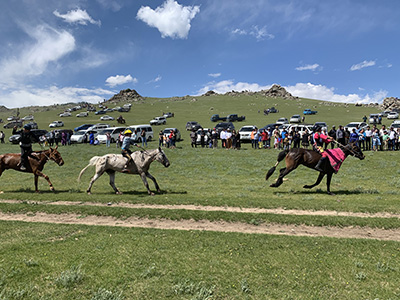 “We were able to go to smaller, more local celebrations, but we got to see traditional Mongolian wrestling and horse racing,” Lima said. “We went to a Mother and Children’s Day celebration where I won a raffle. They were announcing the winners in Mongolian and one of collaborators said, ‘that’s you, go,’ and he pushed me through the crowd into the opening where they were giving out the raffle prizes and everyone started clapping for me. It was really cool. Someone at that celebration asked me to dance. There was music playing but nobody was dancing. It was just the two of us dancing around in this big crowd. It was a fun to experience and be able to do things like that and be welcomed in that way.”
“We were able to go to smaller, more local celebrations, but we got to see traditional Mongolian wrestling and horse racing,” Lima said. “We went to a Mother and Children’s Day celebration where I won a raffle. They were announcing the winners in Mongolian and one of collaborators said, ‘that’s you, go,’ and he pushed me through the crowd into the opening where they were giving out the raffle prizes and everyone started clapping for me. It was really cool. Someone at that celebration asked me to dance. There was music playing but nobody was dancing. It was just the two of us dancing around in this big crowd. It was a fun to experience and be able to do things like that and be welcomed in that way.”
The Mongolia team lived and worked with the locals, spending time in traditional yurts (ger in Mongolian) as well as in tents.
“I really fell in love with the landscapes, these rangelands where you have all of the livestock,” Lima reminisced. “I think my favorite part was just waking up to that every morning, walking outside my tent and seeing yaks right there, just fields and fields of livestock. It is all wide open and that was really cool to experience.”
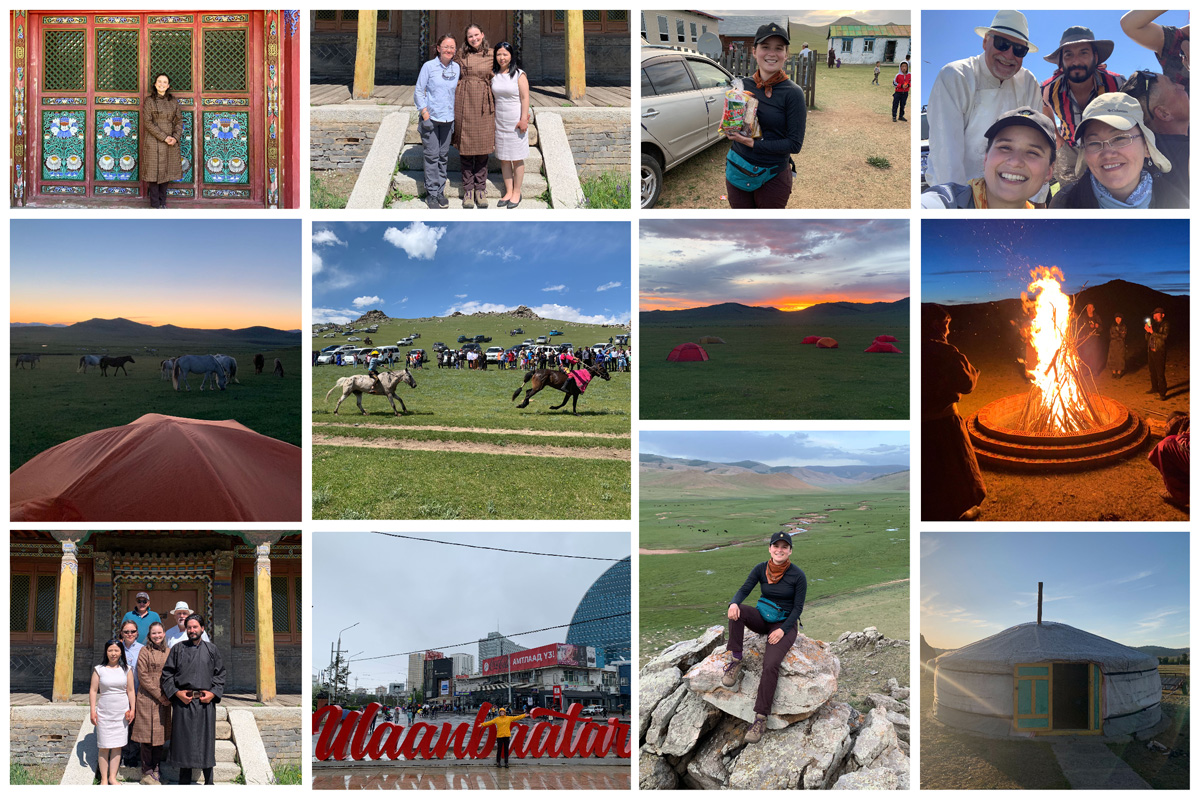 PhD student Sam Lima in Mongolia: (top row left to right) - Lima wearing a tradition deel at a music performance; Lima with two Mongolian scientists; Lima with the raffle prize she won on Mother and Children's Day; the research team while watching wrestling at Naadam; second row (L to R): horses right outside Lima's tent; horse races at Naadam celebration; the team's basecamp in Bayangol; the bonfire after the team's community workshop; bottom row (L to R): the team at a musical event they recorded; Lima in Ulaanbaatar, Mongolia's capital before field work began; Lima in front of the landscape during field work; Lima's ger at the camp
PhD student Sam Lima in Mongolia: (top row left to right) - Lima wearing a tradition deel at a music performance; Lima with two Mongolian scientists; Lima with the raffle prize she won on Mother and Children's Day; the research team while watching wrestling at Naadam; second row (L to R): horses right outside Lima's tent; horse races at Naadam celebration; the team's basecamp in Bayangol; the bonfire after the team's community workshop; bottom row (L to R): the team at a musical event they recorded; Lima in Ulaanbaatar, Mongolia's capital before field work began; Lima in front of the landscape during field work; Lima's ger at the camp In addition to the cultural aspects of the trip, the team had plenty of work to do, setting sensors and using drones to capture video and audio clips, doing plant surveys and interviewing the locals, some of which were new to Lima.
“There were definitely some things we did that I don't think anything could have prepared me, except for being there and doing it,” Lima said. “I didn't take any classes on specifically going into the field but I think that my classes helped me in the preparation, like those focusing on GIS because we did use a lot of maps and whatnot. I think the biggest help was talking to other people in my ESE (Ecological Sciences and Engineering) cohort and my FNR cohort about their experiences doing research, especially women who had done field work, and the kind of things that they've been up to. I learned a lot from my peers that helped me to do research and have helped me become a better scientist, in general.”
Doing research in Mongolia was not without its harrowing experiences.
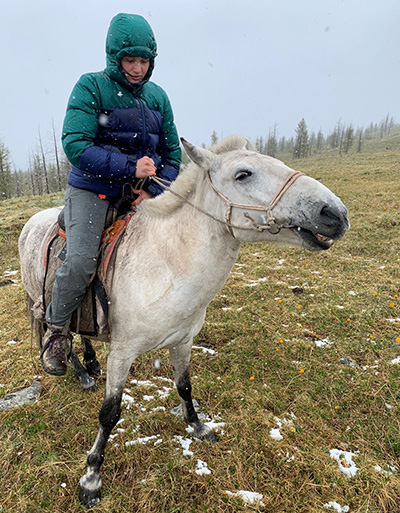 One day, Lima and her colleague Fran were called in to use their drone to help search for a herder who had gone missing. This required them to ride to the top of the mountain and back on horseback.
One day, Lima and her colleague Fran were called in to use their drone to help search for a herder who had gone missing. This required them to ride to the top of the mountain and back on horseback.
“We rode up to the top of this mountain on horseback with the drone to try and look for this herder that was missing,” Lima said. “I was terrified, because we lost the trail on the way back down. The herders were super calm about it. They were like ‘it's fine, we'll just go this way,’ but they are extremely experienced horseback riders. Both Fran and I had some experience riding horses, so we weren’t completely new to it, but it was just a little nerve-wracking. The horses there are a lot smaller and going down that mountain, which was extremely steep, and not having a trail, I was like leaning back the whole time like ‘oh God’. But the herders were all really nice, checking in on us like ‘are you guys good? Are your hands okay?’ because it was cold, etc.”
Lima also experienced what it is like to be sick in a foreign country.
“Apparently I have a weak stomach and a lot of things we ate were unpasteurized, so I ended up having a stomach or gut infection,” Lima recalled. “I knew my stomach was hurting, but I thought I would just drink a lot of water and give it a couple of days. When I got to the point that I realized it was not going to get better on its own, I told Bryan (Pijanowski) I needed to go to the hospital. We went to the closest town, which was super rural. They gave me an IV, but they didn’t have a place for people to stay overnight, so I went to a nearby hotel, which didn’t have running water or an indoor toilet. I really needed to rest and my stomach was not used to Mongolian food, so after getting another IV the next day, we went to a bigger town an hour away. The hotel there is owned by an Australian man and they have some western food there, and I basically laid down for a week and got medicine and IVs and tried to recover. The doctors and nurses and everybody else 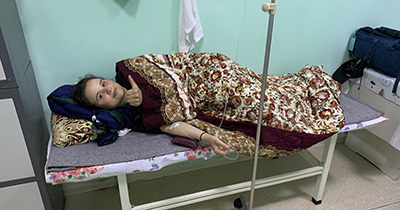 were really nice, but it was definitely nerve wracking even though Bryan was with me and we had a translator with us. Being sick in a foreign country was definitely the most personally challenging part of the trip.
were really nice, but it was definitely nerve wracking even though Bryan was with me and we had a translator with us. Being sick in a foreign country was definitely the most personally challenging part of the trip.
“There's a picture of me in the hospital I took so I could send it to my mom and let her know I was getting the care that I needed and I would be okay and my face is just gray, my lips have no color. When you're out in the field, you just want to do field work and you're super excited about it, so it was hard deciding what my limit was. After that, basically like as soon as I had recovered and finished my course of antibiotics, we went back out into the field and I was feeling a lot better, probably 90 percent. I went directly into doing the plant surveys, which was exhausting work all day in the heat. It was challenging, but I was glad to be back in the field.”
Lima credits two members of the plant survey team, Otgo, a local botanist, and Dr. Chantsaa Jamsranjav, one of the members of the academic team, with educating her on the proper techniques and procedures.
“My background is entirely focusing more on wildlife, animal work and molecular bench work so I had never done plant surveys,” Lima shared. “Frankly I don't have a lot of plant ID capabilities. Going to Mongolia I had no idea what any of this was, so I learned how to do a plant survey in a 70 by 70 meter plot, which is obviously huge for a plant survey. I learned how to do plant surveys and how to ID some of the plants there. 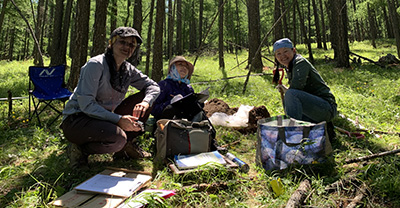 We did surveys of dung and soil surveys. I learned a lot about collecting metadata about the landscape, like landscape features, and how to use little tools like a clinometer and densitometer. I learned all of those techniques. I got to work with Otgo, who was extremely knowledgeable about all the plants and I learned a lot about plant ID from her. Then I learned a lot about rangeland ecology from one of the members of our academic team, Chantsaa, who is originally from Mongolia and did her PhD at Colorado State. They taught me so much.”
We did surveys of dung and soil surveys. I learned a lot about collecting metadata about the landscape, like landscape features, and how to use little tools like a clinometer and densitometer. I learned all of those techniques. I got to work with Otgo, who was extremely knowledgeable about all the plants and I learned a lot about plant ID from her. Then I learned a lot about rangeland ecology from one of the members of our academic team, Chantsaa, who is originally from Mongolia and did her PhD at Colorado State. They taught me so much.”
Otgo and Chantsaa not only educated Lima on work and cultural matters, but engaged in daily activities with her.
“I joked around and called them my Mongolian moms,” Lima said of her colleagues. “Being a woman in fieldwork is definitely a different experience than the men of field work have. I was extremely lucky to have two Mongolian women that I worked with that I was able to look up to and look to for guidance to help me and basically tell me what to do and how to navigate the traditional customs and other experiences. Without them, I would have been really lost. I had a really fun experience doing the plant surveys with them. I also went shopping with them, which was a cool experience because it was a regular activity with friends. They 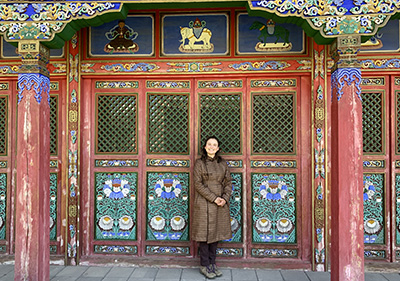 helped me pick out a deel, a traditional Mongolian clothing item, and showed me how to put it on and tie it. A couple weeks after that, we did a recording with musicians and Otgo told me to bring my deel to get pictures in front of the pretty building we were going to.”
helped me pick out a deel, a traditional Mongolian clothing item, and showed me how to put it on and tie it. A couple weeks after that, we did a recording with musicians and Otgo told me to bring my deel to get pictures in front of the pretty building we were going to.”
The three months in Mongolia not only shaped Lima as a person through experiences and skill development, but it also helped her hone the direction of her dissertation work.
“I always knew I would be going to Mongolia and that would be my main focus,” Lima said. “I didn't know specifically what my dissertation would be about. I knew that the project had a huge focus on culture and working with the local communities and taking all that into account in the context of doing ecology in that space. I knew I would be somewhere within that space of how can we as ecologists do mindful, thoughtful work where we work with communities and actually do beneficial things for them, not just for us. My dissertation is probably going to focus on the creation of our project and how we can we use our framework and how we are doing things to help other people plan projects like this where they are being super collaborative and working with locals in ways that are beneficial to them.
“I didn't expect to have such an interest in rangeland ecology. I've always looked at specifics, whether that was with groups of animals or something else, and now my project is looking at more landscape level trends within our study area. Over time, how has the condition of the rangeland changed and how have people changed their lifestyles? I really like the idea of a time series to see how things have changed. My focus definitely has gotten broader after this trip.”
When Lima returns to Mongolia in the summer of 2023, she will doing more acoustic sensor deployment and hopefully more plant surveys, but she also is planning more ethnographic, social science work of talking to people and doing surveys and participatory mapping in line with the IRB she submitted with Dr. Zanotti.
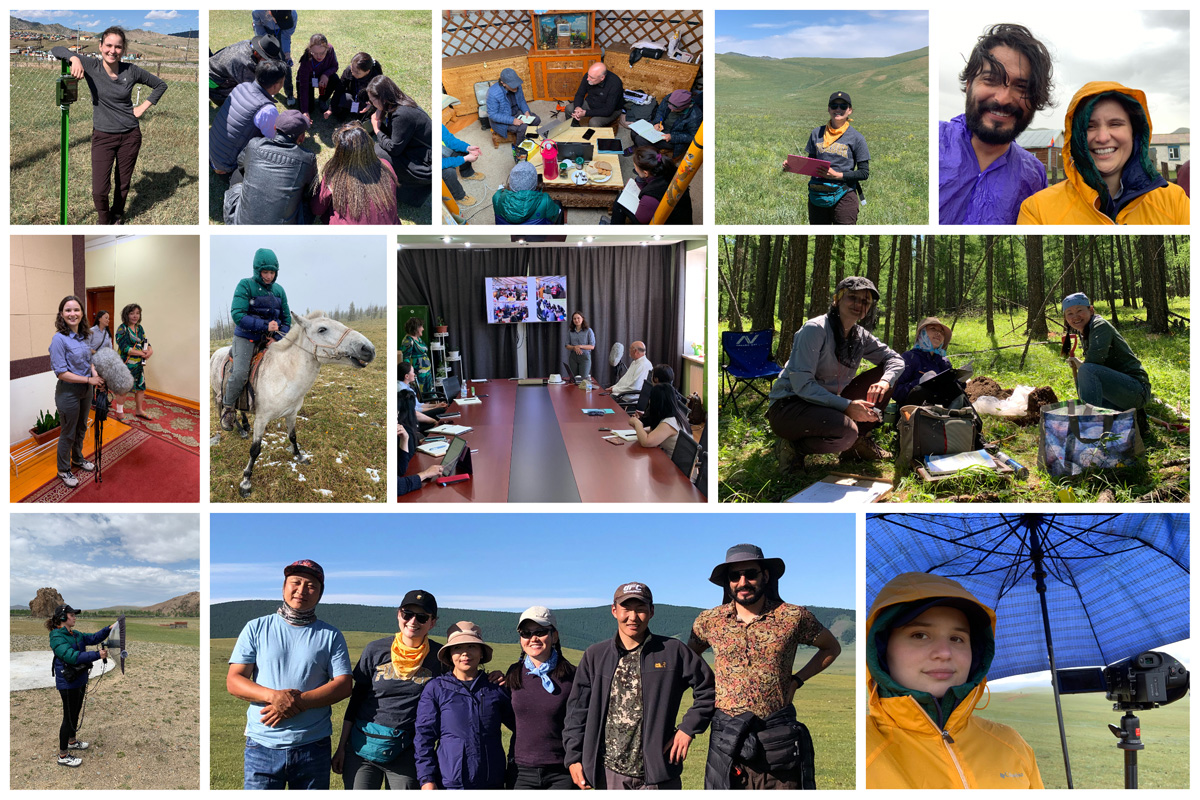 PhD student Sam Lima working in Mongolia. Top row (Left to right) - Lima checking one of the team's sensors in Tsetserleg; Lima leading a soundwalk during the community workshop; fieldwork planning meeting in a ger; Lima taking metadata during a plant survey in Khan Undur; Lima with fellow student Fran in the field on a rainy day; second row (L to R): Lima holding a microphone before an outreach presentation; Lima on a horse going up the mountain searching for a missing herder; Lima presenting the research to local government officials; Lima working on plant surveys with the team; bottom row (L to R): Lima with acoustic equipment in the field; the ecological team without Dr. Pijanowski; Lima recording the horse races in the rain at Naadam.
PhD student Sam Lima working in Mongolia. Top row (Left to right) - Lima checking one of the team's sensors in Tsetserleg; Lima leading a soundwalk during the community workshop; fieldwork planning meeting in a ger; Lima taking metadata during a plant survey in Khan Undur; Lima with fellow student Fran in the field on a rainy day; second row (L to R): Lima holding a microphone before an outreach presentation; Lima on a horse going up the mountain searching for a missing herder; Lima presenting the research to local government officials; Lima working on plant surveys with the team; bottom row (L to R): Lima with acoustic equipment in the field; the ecological team without Dr. Pijanowski; Lima recording the horse races in the rain at Naadam. 

